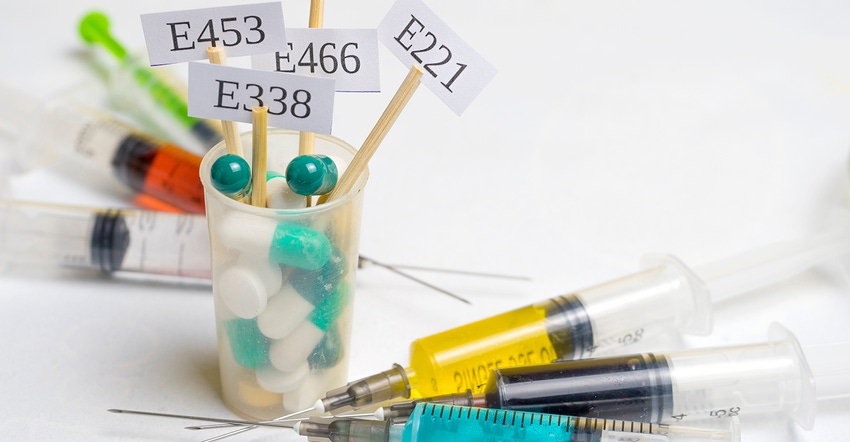Ingredients like whey protein, deer antler, phenethlyamine (PEA) and its derivatives may contain natural substances that give the appearance of adulteration.

Dietary supplements are more popular than ever in the COVID era as consumers seek out products to help with immune support, wellness and general health. Direct-to-consumer (D2C) marketing has grown in this environment, with everyday consumers more informed about products, as well as third-party certification and testing. Quality has become a primary consideration for many supplement users.
As a result, testing for pharmaceutical contaminants like drugs banned in sport is increasingly prevalent as retailers and brands work to elevate their products in the eyes of consumers. But testing is not always simple or straightforward. Differentiating adulteration from natural or environmental presence in dietary supplements is an essential consideration and yet the means for doing so are relatively undefined.
To understand the issues, one must first consider the definition of adulteration. The Federal Food, Drug and Cosmetic Act, Title 21 Section 342 (a)(1) defines adulterated food and dietary supplements as follows:
A food shall be deemed to be adulterated—
(a) Poisonous, insanitary, etc., ingredients
(1) If it bears or contains any poisonous or deleterious substance which may render it injurious to health; but in case the substance is not an added substance such food shall not be considered adulterated under this clause if the quantity of such substance in such food does not ordinarily render it injurious to health.
In the case of things like heavy metals, pesticides or microbiological agents, the industry has established threshold limits that determine whether something may be poisonous or deleterious. Such limits are outlined in guidelines provided by the U.S. Pharmacopeia (USP) or groups like the American National Standards Institute (ANSI). In other countries or regions, like California for example, different limits can be relevant as each jurisdiction may determine its own approach to environmental contaminants. While the limits may vary between countries or groups, at least a model is in place to follow.
The pharmaceutical industry has also established threshold limits on a variety of contaminants. A group called the International Council for Harmonisation of Technical Requirements for Pharmaceuticals for Human Use (ICH) works to standardize allowable limits for a variety of impurities that may be present in drug products. For example, the ICH Q3C focuses on residual solvents, while ICH Q3D concentrates on elemental impurities like heavy metals.
The ICH has also considered the reality that impurities may appear in drugs and has established limit guidelines to appropriately deal with the concern with ICH Q3A – Impurities in New Drug Substances and ICH Q3B – Impurities in New Drug Products. These guidelines are vital in the pharmaceutical industry as they establish allowable levels of unintended substances that may be present. An excerpt from ICH Q3A defines impurities is as follows:
Impurities can be classified into the following categories: · Organic impurities (process- and drug-related) · Inorganic impurities · Residual solvents. Organic impurities can arise during the manufacturing process and/or storage of the new drug substance. They can be identified or unidentified, volatile or non-volatile, and include: · Starting materials · By-products · Intermediates · Degradation products · Reagents, ligands and catalysts. Inorganic impurities can result from the manufacturing process. They are normally known and identified and include: · Reagents, ligands and catalysts · Heavy metals or other residual metals · Inorganic salts · Other materials (e.g., filter aids, charcoal).
Impurities are perhaps more common in the nutrition realm than in the pharmaceutical industry, yet no such model has been developed to evaluate the significance of compounds that could be considered impurities. In nutrition products, impurities may arise from field contamination, treated water used to irrigate fields that contains pharmaceutical compounds, unintended targets of extractions, or natural presence of compounds that are not the primary focus of an ingredient or product. Even though compounds may be present in insignificant parts per billion (ppb) or parts per million (ppm) amounts without a model to consider whether they are injurious to health, these amounts are often treated as adulteration and may result in recalls or regulatory action against the product in question.
With screening for drugs like those on the World Anti-Doping Agency (WADA) Prohibited List on the rise, the dietary supplement industry must consider whether a compound that is identified during testing is adulteration or natural or environmental presence. The industry needs a model similar to ICH to appropriately deal with the presence of unintended compounds as the following examples illustrate.
Whey protein is one of the most popular supplement ingredients on the market. Few people would think that anything on the WADA Prohibited List could be present. Think again. Growth factors in general are prohibited by WADA, including insulin growth factor 1 (IGF-1). Drugs.com notes that as a drug the “synthetic form of Insulin-like growth factor is used to treat growth failure in children, who have problems synthesizing IGF-1, which is necessary for the growth of bones and muscles.”
IGF-1, and other growth factors, are also naturally present in whey protein. IGF-1 does not appear on the label of whey protein products, but it is a known component. Research has noted 1ug/L of IGF-1 in cheese whey with 60ug/L of growth factors (IGF, platelet-derived growth factor [PDGF], transforming growth factor [TGF] and fibroblast growth factor [FGF]).1 Imagine if a testing provider identified IGF-1 in whey protein and determined it to be adulteration. Crazy, right?
Not really. In fact, such an issue occurred in the case of deer antler, another natural product that naturally contains IGF-1. A review by the Therapeutic Goods Administration in Australia noted 0.31 µg/g of IGF-1 in deer velvet antler. Those familiar with sport nutrition and drugs in sport will remember the hysteria that encircled deer antler starting in 2009.
An NFL player tested positive for methyltestosterone after taking a deer antler product marketed as an IGF-1 product and an alternative to steroids. NFL.com reported the player won a $5.4 million settlement in the case in 2013. Questions arose around the coach endorsing the product and why he would suggest that a player use IGF-1. The intrigue around deer antler grew with Baltimore Ravens linebacker Ray Lewis and the 2012 Alabama NCAA football champions noted to be using it according to ESPN. Sports Illustrated reported PGA Tour golfer Vijay Singh admitted to using the same deer antler spray and despite not failing a drug test Singh was accused of doping by the PGA Tour, prompting him to sue for defamation, a case he won five years later.
In the course of evaluating the Singh matter, WADA recognized the natural presence of IGF-1, which is noted in its FAQs: “Very small quantities of IGF-1 can be found naturally in animal products (e.g., colostrums, deer antler velvet).” Research from the WADA accredited laboratory in Salt Lake City in 2013 examined five deer antler supplements (three liposomal solutions, one tincture, and unprocessed deer antler powder) for the presence of human IGF-1 and deer IGF-1, which are distinguishable by their amino acid sequence.2 Human IGF-1 was found in the liposomal products, making them adulterated. Human IGF-1 was not found in the deer antler powder, only deer IGF-1 was present. If a similar powder was used in a dietary supplement, it would not be adulterated as the IGF-1 is naturally present.
Very real consequences can occur if natural presence is considered adulteration in a product, or worse yet a doping infraction, as the IGF-1 example demonstrates. IGF-1 is not alone in this quandary.
Phenethlyamine (PEA) and its derivatives are banned in sport thanks to the Craze dietary supplement affair in 2013. The Craze supplement was suggested to contain dendrobium extract with a variety of chemical names noted on the label. One of them was a close cousin to methamphetamine, N,N-Dimethyl-B-Phenylethylamine (NNDMPEA). The product caused a positive drug test, calling attention to the issue. WADA responded by adding PEA and its derivatives to the prohibited list in 2015.
The problem is PEA and its derivatives are widely present in the plant kingdom. Research notes, “PEA can be found in members of the family Leguminosae, which is the second-largest family of seed plants and is comprised of trees, shrubs, vines, herbs (such as clover) and vegetables (such as beans and peas).”3 PEA is also present in chocolate, cheese and wine.
Fenaroli's Handbook of Flavor Ingredients notes that NNDMPEA is a GRAS (generally recognized as safe) flavoring additive found in PPM amounts in things like baked goods, cheese, condiments, fats and oils, fish products, milk products and more. NNDMPEA is so common it can be found in treated wastewater effluent and is a known environmental contaminant. A poster presented at the International Conference on Environmental Science and Technology in 2010 concluded, “All of the plants, except the carrots, from the field crops watered with Tucson wastewater effluent showed uptake of n,n’DMPEA, an industrial chemical used in manufacturing, food industry, etc.”
Its cousin N-methlyphenetylamine (NMPEA) is also now prohibited in sport. Its presence was documented by Foodb.ca in apple, white cabbage, carrot and cabbage, and is expected to be present in soy and spinach and, “NMPEA is also present at low concentrations (< 10 ppm) in a wide range of foodstuffs.”
These may seem like amusing anecdotes until a dietary supplement product is found to contain NNDMPEA or NMPEA in the course of screening for drugs on the WADA Prohibited List. If these compounds are not expected to be present, or on the label, they may be treated as adulteration.
A new issue arose recently with the addition of ecdysterone to the 2020 WADA Monitoring Program list, meaning the agency is now testing for ecdysterone to determine how common it is in the urine of athletes and whether it should be formally prohibited in the future. Ecdysterone is part of the ecdysteroid family, which are present in, “about 6% of plants in existence.”4 Plants that have higher levels of ecdysteroids include common ones like spinach, quinoa, yams, as well as other more unknown species like Ajuga turkestanica, Rhaponticum carthamoides, Silene praemixta or Vitex scabra. Ecdysterone itself is “the main compound in spinach extract,” as reported in Medical News Today. If ecdysterone is prohibited in the future, and other ecdysteroids follow, this could have major implications in the natural product industry and will amplify the need for an appropriate model to differentiate adulteration from natural presence.
Third-party certification and testing for potential contamination with compounds on the WADA Prohibited List and other problematic pharmaceuticals is designed to showcase a commitment to quality control (QC) on the part of brands and retailers. Taking such a step allows companies to demonstrate to consumers that they have gone above and beyond industry standards to verify the quality of their products. If natural or environmental presence is mistaken for adulteration, however, this commitment can quickly become problematic for those involved. As such issues increase and the overall situation grows more complex, the need to create a consistent model to differentiate adulteration from natural or environmental presence is vitally important to ensure that reasonable products are not deemed to be adulterated.
Oliver Catlin is the longtime president and co-founder of BSCG (Banned Substances Control Group), a leading international third-party certification and testing provider serving the dietary supplement and natural product community. With a background in sports anti-doping, Catlin is widely regarded as a thought leader in the field of sports nutrition and dietary supplements.
References
1 Smithers GW. “Whey and whey proteins—From ‘gutter-to-gold.’” Int Dairy J. 2008;18(7):695-704.
2 Cox HD, Eichner D. “Detection of human insulin-like growth factor-1 in deer antler velvet supplements.” Rapid Commun Mass Spectrom. 2013;27(19):2170-2178.
3 Irsfeld M, Spadafore M, Pruess BM. “Beta-phenylethylamine, a small molecule with a large impact.” WebmedCentral. 2013;4(9):4409.
4 Dinan L. “Phytoecdysteroids: biological aspects.” Phytochemistry. 2001;57(3):325-339.
About the Author(s)
You May Also Like






.png?width=800&auto=webp&quality=80&disable=upscale)